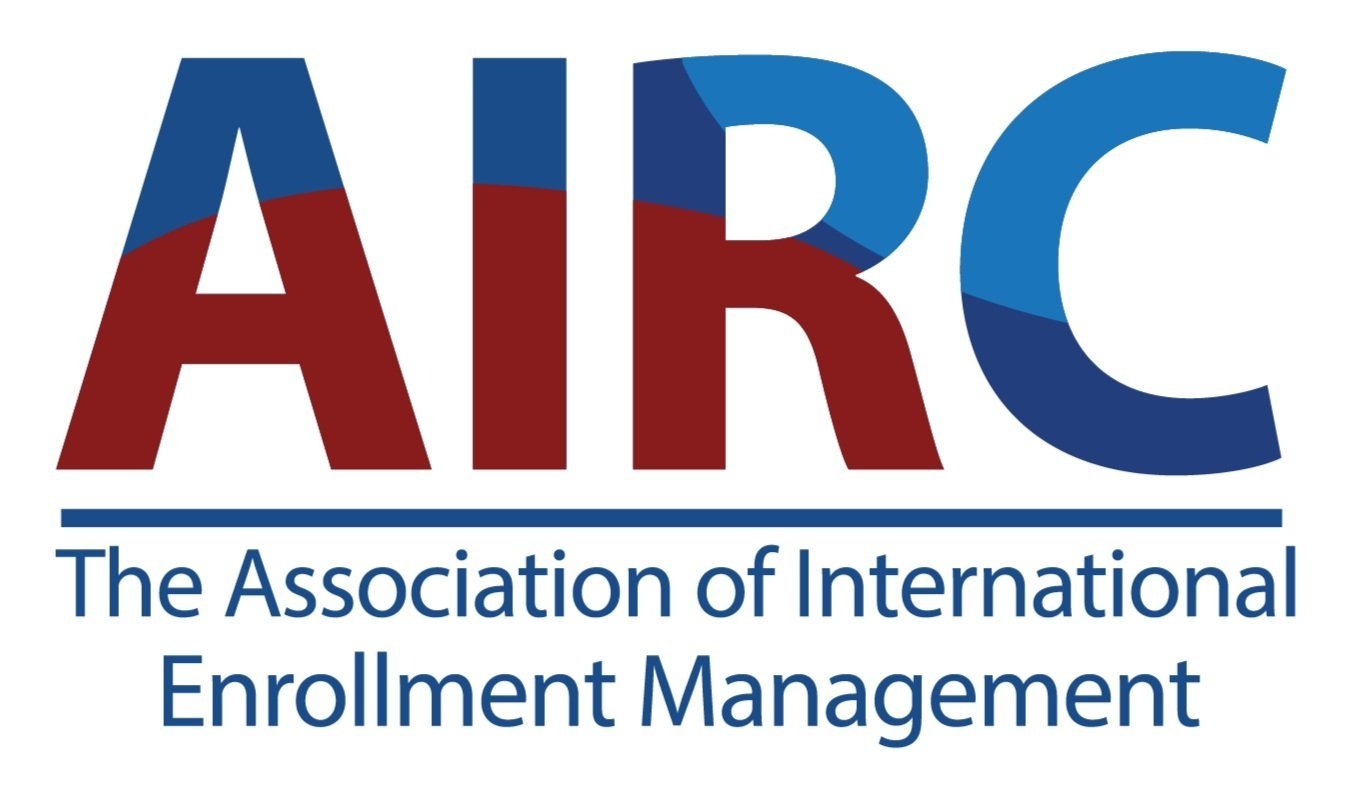Here at AIRC, we are constantly striving to inspire the community, diversify membership and provide all possible resources to our members. Thus, we have developed an all new Strategic Plan that will allow us to accomplish our goals to better serve our members and international students. We have written out how we will work at achieving these goals, and how it will solidify AIRC’s reputation as the association that serves and represents the interests of the international enrollment management field.
MISSION
AIRC champions the interests of international students, educational institutions, and educational agencies through the development of professional standards and partnerships that advance effective and strategic practices in international enrollment management.
A Vision for standards-based recruitment and enrollment for every international student.
I. Objective:
Expand AIRC’s reputation and influence as the leading association that provides expertise to the international enrollment management field.
Goals
Goal 1. Achieve wide recognition of AIRC’s expanded identity and reputation among members, partners and constituents.
Metric: Year 2 and Year 4 surveys of members, partners and constituents regarding AIRC’s mission and purpose.
Actions
A. Emphasize in communications and marketing that AIRC is the only membership association that focuses exclusively on international enrollment management (IEM).
B. Highlight the comprehensive resources, programs and events that AIRC provides to advance success in IEM.
C. Emphasize how AIRC serves the interests of students and engage and integrate students in programming and events when appropriate; conduct and feature assessment of international student outcomes.
D. Distribute AIRC’s new public newsletter and Annual Report widely to non-members and key constituents.
E. Consider rebranding AIRC as: AIRC: Association for International Enrollment Management
Goal 2. Achieve wide recognition of AIRC as a Standards Development Organization (SDO).
Metric: Year 2 and Year 4 surveys of members, partners and constituents regarding the perception and effectiveness of AIRC as a Standards Development Organization.
Actions
A. Advocate for AIRC’s place within the U.S. quality assurance sector by attending and presenting at Center for Higher Education Accreditation meetings, regional accreditation commission meetings, and by communicating regularly with these groups.
B. Collaborate with accrediting bodies to integrate AIRC’s standards into existing accreditation standards where appropriate.
C. Make AIRC’s SDO status and role more visible in AIRC communications by referencing the standards whenever possible and appropriate.
D. Emphasize AIRC’s SDO role and make the standards more visible on the website.
E. Align AIRC resources and programs with the standards.
Goal 3. Influence national policies related to international student enrollment.
Metric: Year 2 and Year 4 surveys of members, partners and constituents regarding AIRC’s impact in shaping national policies related to international student enrollment.
Actions
A. Expand outreach and advocacy efforts.
B. Convene top-level national leaders to discuss and debate the development of a national strategy for international enrollment and publish and promote results and recommendations of these discussions.
C. Establish strong linkages with the leading international education associations, Study State consortia, university systems, agency associations, and related groups in the U.S. and internationally, to leverage AIRC’s influence.
D. Establish and maintain effective relationships with federal and state governments in order to advocate effectively on behalf of members, the field and students.
E. Develop strong working relationships with the media by demonstrating that AIRC is the “go to” source for information and views about IEM.
F. Speak out and advocate on issues and topics related to IEM by referencing standards, and by considering the interests and goals of members and students.
G. Expand AIRC’s participation at key international education conferences, meetings, and discussions.
II. Objective:
Embed the principles of Diversity, Equity and Inclusion into the content and culture of AIRC.
Goals
Goal 1. AIRC members incorporate DEI into their international enrollment management efforts.
Metric: Year 2 and Year 4 member surveys to evaluate the impact of AIRC DEI programs, resources, and services in helping members to incorporate DEI into their international enrollment recruitment efforts.
Actions
A. Incorporate DEI into Certification standards and processes.
B. Develop and deliver workshops on various topics around DEI that highlight AIRC members’ cultures.
C. Create a Resource Center for professional development and education about DEI.
D. Create and offer scholarships to institutional partners/agency partners for students to pursue international education opportunities.
E. Expand the AIRC Mentorship Program to offer more opportunities for equity and inclusion, for agency and new institutional members to participate in the AIRC community.
F. Create discussion topics and threads on the new AIRC Online Discussion Forum.
G. Provide DEI resources to assist educational agencies in preparing students to transition successfully to the U.S. social and political environment.
Goal 2. AIRC becomes an association with a culture of diversity, equity and inclusion.
Metric: Annual evaluation led by Board DEI Chair. External review by DEI expert at Year 2 and Year 4.
Actions
A. Integrate the new Board DEI Chair into AIRC’s decision making processes.
B. Create an annual Board member review process that evaluates contributions to DEI.
C. Incorporate DEI into AIRC hiring and review processes, advocacy efforts, publications,
committees, and conference and website content to encourage organizational cultural change.
III. Objective:
Develop and deliver compelling resources, services and programs that are essential for members to advance their international enrollment management goals, adhere to standards, and that foster a sense of belonging to a supportive community of practice.
Goals
Goal 1. Create effective ways for members to engage with and contribute to AIRC.
Metric: Member survey at Year 2 and Year 4.
Actions
A. Create a moderated, online “AIRC Answers Forum” where members can ask questions, address hot topics, share their expertise, and provide pragmatic solutions.
B. Convene periodic “collegial conversations” that bring together diverse members to share ideas and exchange information.
C. Offer agency-led training opportunities focused on the development of successful partnerships among AIRC members.
D. Establish a professional mentoring program that helps to orient early career professionals to the field and the centrality of a standards-based approach to IEM.
E. Engage former AIRC leaders to contribute actively to the association.
F. Create a “Directory of AIRC Experts” that can contribute to programs, events and resources to help the entire membership.
G. Engage a diversity of members when creating and delivering AIRC resources, programs and events.
H. Communicate regularly the benefits that AIRC delivers to members.
I. Provide multiple, convenient ways for members to connect with AIRC leadership.
J. Conduct consistent evaluation of member programs, events and services, including an annual member satisfaction survey.
Goal 2. Improve how effectively member institutions and organizations adhere to standards.
Metrics: Member survey at Year 2 and Year 4 to evaluate how member institutions and organizations are adhering to AIRC standards. Number of certified and recertified educational agencies.
Actions
A. Create a “standards toolbox” of best practices that includes specific practices from certified educational agencies identified as best practices by certification reviewers. Solicit and choose from member institutions best practice examples that support international enrollment management.
B. Partner with a higher education institution to accredit the ISREP Course, offering graduate credit as an option to participants.
C. Create a Code of Ethics or Statement of Ethical Principles.
D. Develop member-expert publications, including case studies and best practices for IEM.
E. Develop a “Recognized for Meeting Standards” assessment and recognition program for institutional members.
F. Create an “International Enrollment Management Glossary” that shapes and influences the terminology used by the field.
Goal 3. Establish the AIRC Annual Conference as the “must attend” event for international enrollment management.
Metric: Double attendance by Year 5. Conference evaluations that demonstrate high value and relevance of the conference.
Actions
A. Deliver content that is valuable and relevant for all types of members.
B. Address key IEM issues and challenges by inviting national and global leaders to participate in sessions.
C. Attract institutional decision makers to participate by developing program that is relevant to and valuable for them.
D. Make the conference “the event where partnerships are made” among educational agencies, secondary institutions and higher education institutions.
E. Convene the conference in different locations each year.
F. Engage both member and non-member institutions that are located in the regions where the conference is held by offering special “hosting” arrangements.
G. Expand opportunities for sponsors to promote their services.
Goal 4. Collect and analyze data that maps the state of the international enrollment management field and provides information to assist members to meet their goals.
Metric: Number of data collection projects. Member survey to evaluate value and relevance.
Actions
A. Draw on AIRC’s agency members to provide market intelligence research.
B. Conduct an annual survey of international students (“AIRC Student Pulse”) that provides information useful to educational agencies, institutions and the field.
C. Conduct annual survey all AIRC members to map the state of the IEM field.
D. Deliver regular “AIRC Data Insights” via webinars and through top-level infographics.
E. Leverage partnerships with other international education associations and organizations to conduct and publish surveys that provide useful information to AIRC members.
Goal 5. Develop and enhance member benefits for higher education members to assist them to achieve their goals.
Metric: Increase in the number of higher education members by 10% each of the next five years. Achievement of a retention rate of >90%.
Actions
A. Increase membership to expand and deepen expertise to serve AIRC’s community of practice.
B. Partner with other higher education associations that intersect with IEM (eg. URMIA, NACUBO, NACUA) to deliver expert programming that serves members.
C. Create an “AIRC Guide to U.S. Educational Opportunities” to promote the variety of educational opportunities and pathways available to international students.
D. Develop “Recognized for Meeting Standards” assessment and recognition program for institutional members.
E. Conduct targeted outreach to regional international education groups by offering to present AIRC content (ie, survey results, resources) as part of their meetings to demonstrate the value of AIRC membership.
F. Partner with associations such as the Community Colleges for International Development (CCID), the Association of Public and Land-grant Universities (APLU), and others to attract more institutions to join AIRC.
G. Develop effective ways for institutions to arrange communications and meetings with certified educational agencies.
H. Attract new institutions by convening the annual conference in targeted cities to make it easier for institutions to attend, sponsor the conference as “host institutions,” and have opportunities to meet with educational agencies.
Goal 6. Develop and enhance member benefits for secondary education members to assist them to achieve their goals.
Metric: Increase in number of secondary education members to a minimum of 50 total members
within the next 3 years. Achievement of a retention rate of >90%.
Actions
A. Partner with The Association of Boarding Schools (TABS) to develop resources, raise the visibility of AIRC among secondary institutions, and recruit members.
B. Facilitate connections between secondary institutions and certified educational agencies, and between secondary institutions and higher education institutions..
C. Increase membership to expand and deepen expertise to serve AIRC’s community of practice.
D. Create an “AIRC Guide to U.S. Educational Opportunities” to promote the variety of educational opportunities and pathways available to international students.
E. Develop “Recognized for Meeting Standards” assessment and recognition program for institutional members.
F. Develop effective ways for institutions to arrange communications and meetings with certified educational agencies.
G. Attract new institutions by convening the annual conference in targeted cities to make it easier for institutions to attend, sponsor the conference as “host institutions,” and have opportunities to meet with educational agencies.
Goal 7. Develop and enhance member benefits for agency members to assist them to achieve their goals.
Metric: Increase in agency memberships by 15% each of the next 3 years. Achievement of a
retention rate of >90%.
Actions
A. Create new membership categories and pricing for small- and medium-sized educational agencies to make membership more affordable.
B. Develop an accessible, clearly understood pathway to certification that includes an option for “stackable certification.”
C. In partnership with agency members, create and deliver US higher education overview sessions for prospective students and families, thereby delivering value to agency members.
D. Launch an agency campus visit program in conjunction with the annual conference as it rotates to different cities.
E. Create an Agency-India AIRC Chapter as a way to serve the specific needs of agency members in India, and attract new members.
F. Promote models for successful relationships between institutions and educational agencies.
G. Collaborate with ICEF to create linkages between ICEF agency training and AIRC certification.
H. Attract new agency members through the TABS partnership.
I. Promote agency college fairs on AIRC website.
J. Conduct regular virtual information sessions for prospective agency members.
K. Launch “Agency Academies” and “Agency Mentors” to assist educational agencies to be successful.
L. Provide a reference letter for certified educational agencies that can serve as part of a letter of introduction when they contact institutions.
M. Make the institutional information in the member directory more useful to agency members.
Thank you
We thank the many colleagues who contributed to the development of the strategic plan, including the Strategic Planning Task Force, Board of Directors, Certification Commission, and leaders of our sister associations. Most of all, we thank the many members who contributed to the process by filling out surveys, participating in listening sessions, and by providing essential feedback on drafts of the strategic plan. Their input provided much of the content and shape of the plan.


























